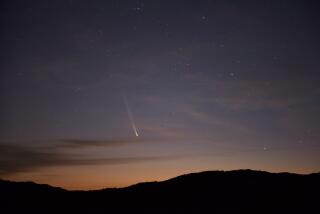A comet is about to fly by Mars: Here’s everything you need to know

- Share via
On Sunday, a comet the size of a mountain will brush past Mars, passing just 87,000 miles away from the red planet.
That’s about one-third the distance between the Earth and the moon, and scientists say it is likely closer than any comet has gotten to Mars in about 1 million years.
The Mars-grazing comet is called C/2013 A1, but you can call it Comet Siding Spring for short. Siding Spring is the name of the Australian observatory from which it was first spotted.
Scientists say the nucleus of the comet is between half a mile and 5 miles wide, and if it is similar to the nucleus of other comets, it likely has the tensile strength of meringue in lemon meringue pie or a pile of talcum powder, said Carey Lisse, principal scientists at Johns Hopkins University Applied Physics Laboratory.
The gas cloud that surrounds the nucleus is 12,000 miles across. The comet’s massive tail extends the equivalent of the distance between the Earth and the moon.
At the time of its closest approach to Mars it will be speeding through space at 34 miles per second.
Soon after the comet was discovered in January 2013, officials at NASA and the European Space Agency grew concerned that dust from the comet’s tail could damage spacecraft in orbit around Mars.
Even a microscopic piece of dust moving at rapid speeds is capable of cracking a glass lens, or knocking out a computer board, they said.
Extensive computer models built by three different teams revealed that dust from the comet has a very slim chance of hitting any spacecraft. Still, NASA and the ESA made some minor alterations to their orbiters trajectory to ensure they will all be ducking on the far side of Mars from the comet just after its closest approach, when the risk of a dust collision is the highest.
“There’s a small probability of an impact, but it’s not zero,” Richard Zurek, chief scientist for the Mars Program Office at NASA’s Jet Propulsion Laboratory, told the Los Angeles Times. “And it only takes one to do you in.”
Now that the orbiters are considered safe, researchers can focus on observing the comet as well as the gases and dust particles it is spewing into space. Using the Mars rovers, the Mars orbiters (after they come out of hiding) and a suite of telescopes in space and on Earth, scientists are hoping to learn what the comet is made of, what its nucleus looks like, how fast it is spinning, and how its corona will interact with the atmosphere of Mars.
This is not the first time that spacecraft will get a good look at a comet. In 2005 NASA’s Deep Impact mission made contact with comet 9P/Tempel 1, and the ESA’s Rosetta Mission is hoping to land on comet 67P/Churyumov–Gerasimenko on Nov. 12. But both those comets are short period comets that have made several trips around the sun.
Comet Siding Spring, on the other hand, hails from the Oort cloud, an icy region at the very edge of our solar system. It likely formed about 4.6 billion years ago, at the same time as the planets. Because it has spent most of its life in a deep freeze, the primordial materials embedded in its nucleus have been preserved.
Scientists say this is Siding Spring’s first journey to the inner solar system, and they hope it will provide fresh clues to the early days of the planet formation.
As for seeing this comet for yourself -- don’t count on it. If you lived on Mars it would definitely be a naked eye object, but it will not be from here on Earth.
“From the Earth it is what we call an 11th magnitude object, which means it would take a good telescope at least 6 inches wide and a very dark sky to find the comet,” Lisse said.
And even with a good telescope, the comet will not be visible in the Northern Hemisphere, unless you live within 10 degrees of the equator. Viewing is mostly restricted to those who live in Australia, Africa and South America.
However, if you are willing to do your comet watching via the Internet, you can still get in on the fun. The astronomy website Slooh.com will be live streaming a view of Siding Spring and Mars from its telescopes in South Africa and the Canary Islands. The broadcast begins at 11:15 a.m. PDT on Sunday.
NASA said it should have its first images of the comet taken by the Mars orbiters and rovers ready to share early next week. If we get lucky, Curiosity or Opportunity will be able to send back our first look at a comet from the surface of another planet. And that would be pretty amazing.
Science rules! Follow me @DeborahNetburn and “like” Los Angeles Times Science & Health on Facebook.







